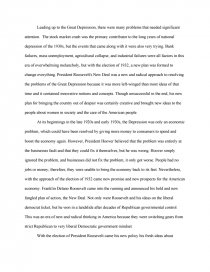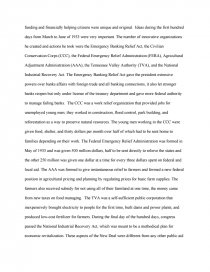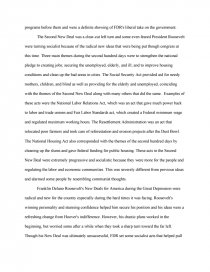The New Deal
Essay by review • March 21, 2011 • Essay • 1,039 Words (5 Pages) • 1,236 Views
Leading up to the Great Depression, there were many problems that needed significant attention. The stock market crash was the primary contributor to the long years of national depression of the 1930s, but the events that came along with it were also very trying. Bank failures, mass unemployment, agricultural collapse, and industrial failures were all factors in this era of overwhelming melancholy, but with the election of 1932, a new plan was formed to change everything. President Roosevelt's New Deal was a new and radical approach to resolving the problems of the Great Depression because it was more left-winged than most ideas of that time and it contained innovative notions and concepts. Though unsuccessful in the end, his new plan for bringing the country out of despair was certainly creative and brought new ideas to the people about women in society and the care of the American people.
At its beginnings in the late 1920s and early 1930s, the Depression was only an economic problem, which could have been resolved by giving more money to consumers to spend and boost the economy again. However, President Hoover believed that the problem was entirely at the businesses fault and that they could fix it themselves, but he was wrong. Hoover simply ignored the problem, and businesses did not fix the problem, it only got worse. People had no jobs or money; therefore, they were unable to bring the economy back to its feet. Nevertheless, with the approach of the election of 1932 came new promise and new prospects for the American economy. Franklin Delano Roosevelt came into the running and announced his bold and new fangled plan of action, the New Deal. Not only were Roosevelt and his ideas on the liberal democrat ticket, but he won in a landslide after decades of Republican governmental control. This was an era of new and radical thinking in America because they were switching gears from strict Republican to very liberal Democratic government mindset.
With the election of President Roosevelt came his new policy his fresh ideas about funding and financially helping citizens were unique and original. Ideas during the first hundred days from March to June of 1933 were very important. The number of innovative organizations he created and actions he took were the Emergency Banking Relief Act, the Civilian Conservation Corps (CCC), the Federal Emergency Relief Administration (FERA), Agricultural Adjustment Administration (AAA), the Tennessee Valley Authority (TVA), and the National Industrial Recovery Act. The Emergency Banking Relief Act gave the president extensive powers over banks affairs with foreign trade and all banking connections, it also let stronger banks reopen but only under license of the treasury department and gave more federal authority to manage failing banks. The CCC was a work relief organization that provided jobs for unemployed young men; they worked in construction, flood control, park building, and reforestation as a way to preserve natural resources. The young men working in the CCC were given food, shelter, and thirty dollars per month over half of which had to be sent home to families depending on their work. The Federal Emergency Relief Administration was formed in May of 1933 and was given 500 million dollars, half to be sent directly to relieve the states and the other 250 million was given one dollar at a time for every three dollars spent on federal and local aid. The AAA was formed to give instantaneous relief to farmers and formed a new federal position in agricultural pricing and planning by regulating prices for basic farm supplies. The farmers also received subsidy for not using all of their farmland at one time, the money came from new taxes on food managing. The TVA was a self-sufficient public corporation that inexpensively
...
...



